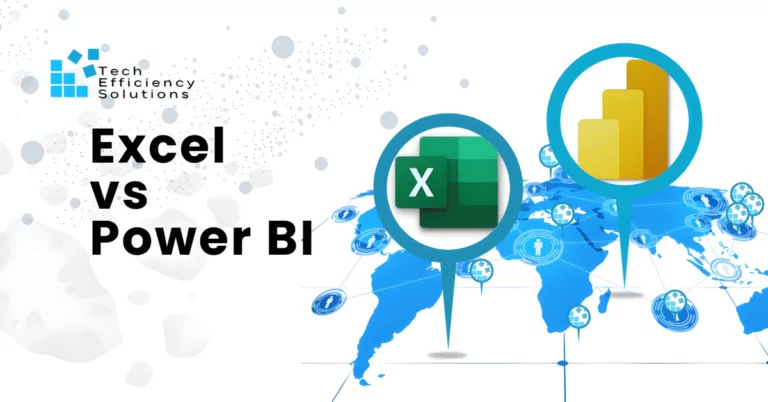Excel vs Power BI: Which One is Better?
- Corby Haynes
- February 19, 2024
- Time to read: 5 min

Microsoft Excel and Power BI, two powerful tools from the Microsoft Suite, share a common goal: to make data analysis accessible, efficient, and insightful.
However, while they share these similarities, they are not identical.
Let’s find out what their key differences are and how to choose the right tool for your specific requirements.
What is Microsoft Excel?
Excel is a spreadsheet tool from Microsoft that was introduced in 1985. Businesses widely use it for storing, sorting, and changing data. Excel can also do complicated math and create basic charts. Many businesses use Excel for budgeting, analyzing finances, managing projects, and tracking inventory.
Key Features:
- Formulas and functions are being used for calculations and data manipulation.
- Pivot Tables are useful for summarizing and analyzing large datasets.
- Charts and graphs help visualize data trends and patterns.
- Data Filtering allows focus on specific data subsets.
- Conditional Formatting highlights key results or outliers.
- Data Validation prevents incorrect data entry.
- VLOOKUP and HLOOKUP match and retrieve data across different datasets.
- Macros automate repetitive tasks like generating reports.
- Solver is useful for complex analyses like optimization problems.
- Data Tables allow viewing results of multiple scenarios.
- What-if Analysis helps model different scenarios and understand potential outcomes.
What is Power BI?
Power BI, launched by Microsoft in 2014, is a tool for viewing data and analyzing it. It helps businesses connect to many different data sources, makes preparing data easier, and supports spontaneous analysis. Power BI is often used to make detailed business reports, dashboards, and complex visuals that can be shared within a company.
Key Features:
- Offers a consolidated view of business data with interactive dashboards.
- Power Query feature lets you connect to various data sources, transform and clean that data.
- Allows users to create relationships between data from different sources, define new calculated columns and measures using DAX (Data Analysis Expressions) language.
- Power Pivot is used for data modelling and creating data relationships. It’s also used to create calculated columns and measures.
- Allows users to design interactive reports and visualizations.
- Offers a variety of charts, graphs, maps, and other visuals to represent data in a user-friendly manner.
- Power BI Service is a cloud-based service that publishes Power BI reports and data visualizations.
- Allows real-time streaming and visualization of data, which helps monitor timely information like social media metrics or IoT data.
- Offers apps for iOS and Android devices, allowing users to access dashboards and reports on the go.
- Integrates well with other Microsoft products like Excel, Azure, SQL Server, and many other third-party services.
Recommended read: What is Power BI and How to Use it?
Similarities of Power BI and Excel
Here are some of their common features:
- Data Analysis: Both Power BI and Excel offer a range of data analysis tools. You can perform calculations, create formulas, and use built-in functions to analyze your data.
- Visualization Tools: Both tools allow you to create visual representations of your data, such as charts and graphs. These can help to make complex data more understandable.
- Integration with Microsoft Products: Both Excel and Power BI integrate well with other Microsoft software, such as SharePoint and Microsoft 365. This makes it easy to import and export data between different programs.
- PivotTables and PivotCharts: Both tools support the creation of PivotTables and PivotCharts, which are powerful features for summarizing, analyzing, exploring, and presenting your data.
- Data Connection: Both Power BI and Excel can connect to a wide variety of data sources, from simple CSV files to complex databases.
- Power Query: Both tools use Power Query for data transformation and data cleaning tasks. It’s a user-friendly tool that allows you to prepare your data for analysis.
- DAX (Data Analysis Expressions): Both Power BI and Excel (specifically Power Pivot in Excel) use DAX, a formula language that allows users to perform custom calculations on data models.
Quick Comparison Summary: Power BI vs Excel
Feature | Excel | Power BI |
Data Capacity | Can handle over one million rows of data but slows down as file size increases | Can handle much larger data sets without compromising performance |
Data Visualization | Offers basic tools like charts and graphs | Excels with interactive dashboards and reports for intuitive data exploration |
Data Analysis | Provides data analysis functions | Provides more advanced features like quick measures and forecasting |
User-Friendliness | Familiar and user-friendly interface | Steeper learning curve but easy to use with drag-and-drop features once familiar |
Collaboration | Files are often shared via email, can lead to version control issues | Allows multiple users to collaborate on the same dashboard or report in real time |
Integration | Integrates well with other Microsoft products | Besides integrating well with Microsoft products, it can connect to a broader range of data sources |
Pricing | Comes with Microsoft Office Suite, cost-effective for small businesses | Free for basic use, requires a subscription for more advanced features |
When to use Excel?
Excel is a powerful tool that is particularly effective when working with small datasets. This is because it has the capability to manage data up to one million rows, but as the file size increases, the performance may slow down. Therefore, for smaller datasets, Excel can handle the data efficiently without any performance issues.
Moreover, Excel excels when complex calculations are necessary. It’s equipped with a large number of mathematical functions, including statistical, engineering, and financial functions. This makes it a smart choice for tasks that require detailed and intricate computations.
Case Studies:
- Investment Firms: These firms often use Excel for financial modelling, where detailed and intricate calculations are needed to predict future financial performances based on past data.
- Marketing Agencies: Excel is commonly used by these agencies for project tracking. It enables them to create detailed schedules, allocate resources, and monitor progress effectively.
When to use Power BI?
Power BI is the better choice for handling large datasets and creating advanced, interactive visualizations. It’s also perfect for collaborative projects and real-time reporting. Businesses have used Power BI to monitor real-time sales performance and to track customer behavior patterns.
Case Studies:
- Integrated Performance Dashboards: Power BI was employed to design unified dashboards, assisting leaders in making educated choices through data analysis and visualization.
- Supply Chain Management: Power BI was used to create a live dashboard for overseeing supply chain operations, setting the stage for additional research into using more advanced business intelligence tools.
Work With Tech Efficiency Solutions
Now that you understand the difference between Excel and Power BI, you can make more informed decisions about which tool is right for your needs. If you lack the time or resources to execute these tasks, consider partnering with Tech Efficiency Solutions, a Microsoft apps specialist. We help businesses of all sizes in analyzing their data using Power BI. Contact us today for a free consultation.
FAQs
Q: Is Power BI better than Excel?
Generally, both Excel and Power BI serve different purposes. Excel is great for small datasets and simple calculations, while Power BI is ideal for larger datasets, advanced visualizations, and real-time analytics.
Q: Can I learn Power BI without Excel?
Yes, you can learn Power BI without prior knowledge of Excel. However, having a basic understanding of Excel can make learning Power BI easier as some concepts are similar.
Q: Is Excel good for jobs?
Absolutely. Many jobs, especially in business and finance, require proficiency in Excel. It’s a versatile tool used for data analysis, creating charts, and managing information. Knowledge of Excel is often seen as a valuable skill by employers.
- 5 Common Mistakes in SharePoint Governance and How to Avoid Them - June 5, 2024
- How to Use Microsoft Forms: A Beginner’s Guide - June 1, 2024
- What is Microsoft Bookings? - May 26, 2024

